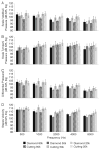Drill-induced Cochlear Injury During Otologic Surgery: Intracochlear Pressure Evidence of Acoustic Trauma
- PMID: 28598950
- PMCID: PMC5535777
- DOI: 10.1097/MAO.0000000000001474
Drill-induced Cochlear Injury During Otologic Surgery: Intracochlear Pressure Evidence of Acoustic Trauma
Abstract
Hypothesis: Drilling on the incus produces intracochlear pressure changes comparable to pressures created by high-intensity acoustic stimuli.
Background: New-onset sensorineural hearing loss (SNHL) following mastoid surgery can occur secondary to inadvertent drilling on the ossicular chain. To investigate this, we test the hypothesis that high sound pressure levels are generated when a high-speed drill contacts the incus.
Methods: Human cadaveric heads underwent mastoidectomy, and fiber-optic sensors were placed in scala tympani and vestibuli to measure intracochlear pressures (PIC). Stapes velocities (Vstap) were measured using single-axis laser Doppler vibrometry. PIC and Vstap were measured while drilling on the incus. Four-millimeter diamond and cutting burrs were used at drill speeds of 20k, 50k, and 80k Hz.
Results: No differences in peak equivalent ear canal noise exposures (134-165 dB SPL) were seen between drill speeds or burr types. Root-mean-square PIC amplitude calculated in third-octave bandwidths around 0.5, 1, 2, 4, and 8 kHz revealed equivalent ear canal (EAC) pressures up to 110 to 112 dB SPL. A statistically significant trend toward increasing noise exposure with decreasing drill speed was seen. No significant differences were noted between burr types. Calculations of equivalent EAC pressure from Vstap were significantly higher at 101 to 116 dB SPL.
Conclusion: Our results suggest that incidental drilling on the ossicular chain can generate PIC comparable to high-intensity acoustic stimulation. Drill speed, but not burr type, significantly affected the magnitude of PIC. Inadvertent drilling on the ossicular chain produces intense cochlear stimulation that could cause SNHL.
Conflict of interest statement
No potential conflict of interest was reported by the authors.
Figures






References
-
- Tos M, Lau T, Plate S. Sensorineural hearing loss following chronic ear surgery. Ann Otol Rhinol Laryngol. 1984;93(4 Pt 1):403–409. - PubMed
-
- Smyth G. Sensorineural hearing loss in chronic ear surgery. Ann Otol. 1977;86:3–8. - PubMed
-
- Palva T, Kärjä J, Palva A. Immediate and short-term complications of chronic ear surgery. Arch Otolaryngol. 1976;102(3):137–139. - PubMed
-
- Palva T, Kärjä J, Palva A. High-tone sensorineural losses following chronic ear surgery. Arch Otolaryngol. 1973;98(3):176–178. - PubMed
MeSH terms
Grants and funding
LinkOut - more resources
Full Text Sources
Other Literature Sources
Miscellaneous

